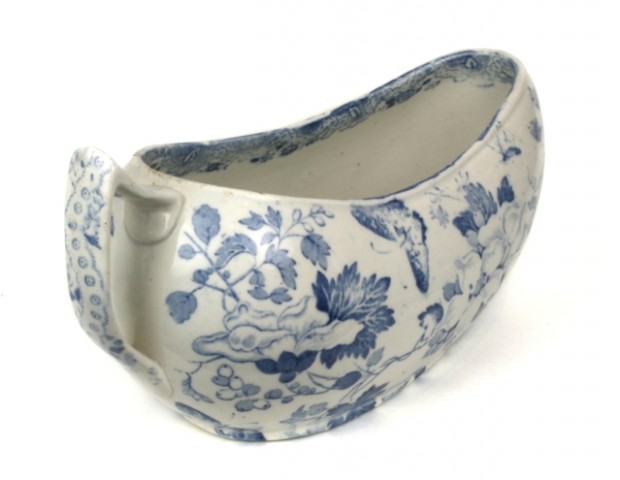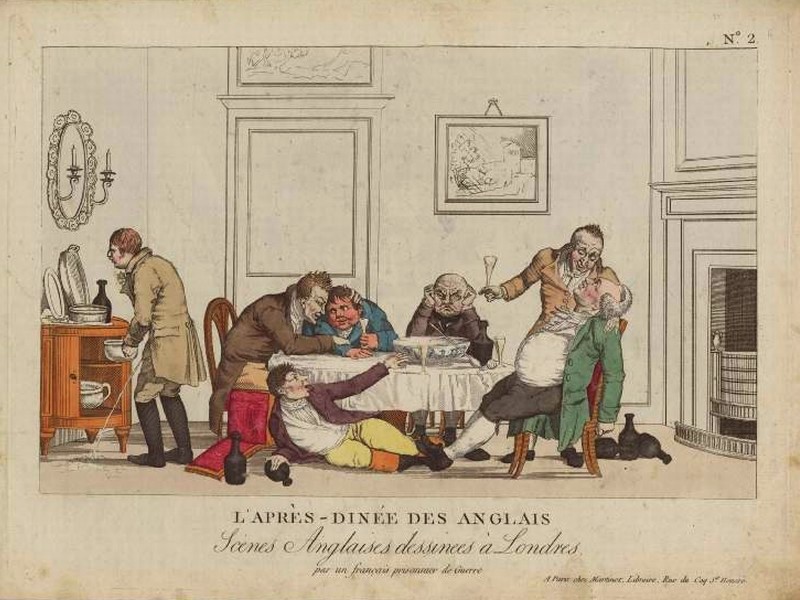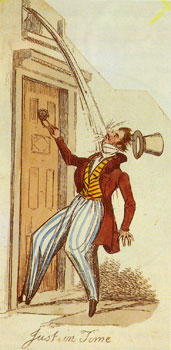
A bordaloue for ladies to relieve themselves under their skirts
Tara K, who has sent me a raft of interesting questions including glove etiquette, whether ladies could say “cheese”, and why certain conveyances were painted yellow, has sent a new batch to try and “stump the historian.”
I knew it was inevitable we would get to the bodily functions questions.
Her actual question was pretty detailed, but I want to summarize the meat and potatoes, because honestly there is not ton of obvious source material on the subject to be able to answer all the questions. Not surprisingly, there aren’t a lot of writers in the 19th Century talking about number one and two.
Tara had all sorts of questions related to the necessary, but I am summing it up thus: where did Regency ladies pee and who managed the pee (if it was in pots or bourdaloues).
Regina Jeffers talks a bit about it in this post, and suggest, very sensibly, that ladies didn’t drink or eat much at public functions to avoid having to relieve themselves. Its hard to imagine wanting to cart a bourdaloue all over kingdom come, and besides, nerves combined with wanting to appear demure would like dampen a hearty thirst or appetite.
For those who couldn’t resist courses and wine, Jeffers suggests that most ladies at supper likely waited until they were excused to do their business. That would give them a brief window after dinner to take care of their bladders or other ablutions. I imagine a considerate hostess would prepare a sort of retiring room in a closet or other nearby parlor for ladies to use, for certain that a lady might need to blot a stain or fix a hem. She may even let them use her room, or a room connected to the parlor. When all else failed, a trusty bourdaloue or communal chamber pot in the corner probably worked.
Gentleman, evidently, got to go behind a screen to piss in a pot even during dinner, although I imagine the screens were in corners and discreet (I believe the satirical drawings are an exaggeration, as they often are of their intended targets). It is even said that a lady in urgent need might shuffle over behind a screen to relieve herself. Its hard to imagine jumping out of your seat (a no, no, by all accounts) in a crowded room to duck behind a curtain and not get “stage fright”, not mention look everyone in the eye afterwards…I remember girlfriends in the past who needed someone to accompany them with singing in a public bathroom to get over the noise-embarrassment. But maybe life before closets with toilets was desensitizing enough that no one blinked an eye. One post here recounts a tale of the French ambassador’s wife who would annoy “everyone with ‘frequency and quantity of her pissing which she does not fail to do at least ten times a day amongst a cloud of witnesses’.
There are some suggestions that it was common practice while out in Town to duck down an alley to wee (as I am sure a drunken night or two might attest to, even now), so again there appeared to be less inhibitions when it came to the necessary. In fact, Uncle John’s Bathroom Reader suggests it was so common for people to pee and poo just about everywhere, there was advice on etiquette when meeting an acquaintance answering the calls of nature: Act like you don’t see them. With that sort of behavior commonplace, its highly probable that there was something very everyday about overhearing someone relieving themselves and therefore not a source of shock and dismay.

Its also worthwhile to remember that places were a lot darker generally when lit by candelight, so more opportunities for shadows, dark corners, and other places to discreetly twitch up your skirts and slip in the old gravy boat for a slash.
Vic at Jane Austen’s World, who is an excellent researcher, suggests that bourdaloues were indeed common throughout the 19th century until water closets were more pervasive, and that most ladies having urgent needs would indeed have to “retreat to a darker more private corner…to urinate” into the gravy boat looking bourdaloue, careful not to muss or soil her skirts. This would have been easier given the fact that Regency ladies didn’t wear knickers (yep, you read that right. no panties. no unders. a whole lotta undergarments, but they were crotchless).
There might also be a chamber pot behind a screen, but sharing chamber pots was not common or advisable, although maybe for parties they brought out the big ones? Mrs. Beeton’s book recommended empting chamber pots daily, just after the housemaid served breakfast. It would have been a normal, routine part of the day and most would’ve been stored in each room in a convenient, discreet place like under the bed or near the wash basin. Similarly, the emptying and care of the bourdaloue would’ve been the domain of the ladies maid or for the gentleman, a footman or valet.
However, its highly likely that there were many occasions where a ladies’ maid was not in attendance. In the Regency, with slimmer lines and less underskirts, it was probably relatively easy for a young lady to twitch up her skirts and squat over a chamber pot, especially if she was used to that position. For the Georgian or Victorian era, with wider skirts, hoops or bustles and a lotta layers, a bourdaloue would’ve been a lot safer. I suspect in those cases, a young lady might bring that (along with any number of other things) in a sort of case to a long supper or ball. For shorter events, I guarantee is when as Jeffers suggests those with small bladders abstained from food or drink. I also read that coaches were typically equipped with a sort of coach bourdaloue so that the occupant might go when the urged hit. I am not sure how one would accomplish this discreetly, but maybe it was similar to the street phenomena, you look away and pretend to see and hear nothing.
There isn’t a lot of material on who, when personal maids were absent, would attend to full pots, but I would guess that at a house party or public event (like the opera) it would fall to the staff on site to see this was dealt with discreetly. I certainly make sure, when I am having a party, to stock the toliet paper and keep the bathroom clean so I can easily see a butler or other household staff assigning a footman or maid to be in charge. For families or situations with little to no staff, then I imagine a person was comfortable enough to empty their own slops.
It makes you wonder how ladies with IBS, UTIs, or the like survived.

Tara has many more wonderful, very hard to research questions…so stay tuned. I likely will have another post on bathroom behaviors, so don’t despair if all your burning questions were not answered.
You can watch a demonstration by Lucy Worsley using the bourdaloue here: https://www.youtube.com/watch?v=inoVg5a1kps&feature=youtu.be
This gal also has some details and pictures from her reinactments for some possible methods: http://lbcchistorical.blogspot.com/2014/11/getting-personally-aquatinted-with.html
A nice, comprehensive post about peeing in the Regency: https://uncommon-courtesy.com/category/thank-goodness-we-dont-have-to-do-that-anymore/page/2/











